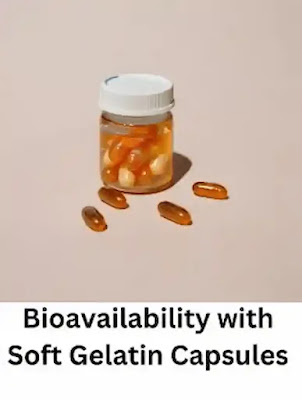Soft gelatin capsules (SGCs), also known as soft gels, offer a versatile and effective solution for enhancing the
bioavailability of poorly soluble drugs. These single-unit dosage forms
provide a liquid matrix that can solubilize and protect drug molecules, leading to improved absorption and therapeutic efficacy. This article explores the various formulation and delivery
approaches employed in SGCs to maximize bioavailability.
Challenges of Poorly Soluble Drugs:
Many promising drug candidates
suffer from poor water solubility, limiting their oral bioavailability. This translates to reduced absorption in the
gastrointestinal tract (GIT), leading to suboptimal therapeutic
effects. SGCs address this challenge by
incorporating the drug into a liquid fill material, often consisting of oils, surfactants, and co-solvents. This formulation strategy enhances
drug solubilization and facilitates its release in the GIT, ultimately leading to improved absorption and
bioavailability.
Formulation Approaches for SGCs:
Several formulation strategies can
be employed within SGCs to further enhance bioavailability:
- Self-emulsifying drug delivery systems (SEDDS): SEDDS are anhydrous, isotropic mixtures of oils, surfactants, and co-solvents that
spontaneously form fine oil-in-water emulsions upon contact with aqueous
fluids in the GIT. This rapid emulsification maximizes drug release and
absorption.
- Self-micro emulsifying drug delivery systems (SMEDDS): Similar to SEDDS, SMEDDS are self-emulsifying but contain higher
surfactant concentrations, resulting in even finer oil-in-water micro emulsions. These micro emulsions offer
enhanced drug solubilization and increased bioavailability.
- Lipid-based formulations: Oils and lipids are often incorporated into SGCs due
to their ability to solubilize poorly soluble drugs. Common examples include
medium-chain triglycerides, long-chain triglycerides, and fatty acid esters.
- Solid dispersions: In solid dispersions, the drug is dispersed in a solid carrier matrix, such as polymers or excipients, using techniques like spray
drying or hot-melt extrusion. This approach can improve drug solubility and
dissolution rate, leading to enhanced bioavailability.
- Co-solvent systems: Co-solvents are miscible with both water and the drug, enabling increased drug
solubilization in the SGC fill material. However, careful selection of co-solvents is crucial due to
potential toxicity and volatility concerns.
Delivery Approaches for SGCs:
Several delivery approaches can be
employed within SGCs to optimize drug release and absorption:
- Enteric coatings: Enteric coatings can be applied to SGCs to prevent
drug release in the acidic environment of the stomach and ensure release
in the more alkaline environment of the small intestine, where absorption is maximized.
- Taste masking: Poorly tasting drugs can be masked within the SGC
fill material or by employing taste-masking coatings on the capsule shell.
- Modified-release formulations: SGCs can be designed to achieve sustained or delayed
drug release profiles through various approaches, such as incorporating matrix
systems, osmotic pumps, or reputable coatings.
Advantages of SGCs:
SGCs offer several advantages over
other oral dosage forms:
- Enhanced bioavailability: SGCs can significantly improve the bioavailability of
poorly soluble drugs compared to traditional tablets or capsules.
- Improved stability: The liquid fill material within SGCs protects the
drug from degradation and ensures consistent drug release.
- Dosage flexibility: SGCs can be formulated to deliver a wide range of
drug doses, including low and ultra-low doses.
- Patient compliance: SGCs are generally easy to swallow and offer a smooth, tasteless experience, improving patient compliance.
- Manufacturing advantages: SGCs can be manufactured in a cost-effective and
scalable manner.
Unlocking the Potential of Poorly Soluble Drugs through Advanced Formulation and Delivery Approaches
Poorly soluble drugs represent a
significant challenge in pharmaceutical development, often resulting in limited bioavailability and reduced
therapeutic efficacy. Fortunately, innovative solutions like soft gelatin capsules (SGCs)
offer a promising path to overcome these hurdles and unlock the full potential
of these drugs. This article delves into the world
of SGCs, exploring the latest formulation
and delivery approaches used to enhance drug bioavailability and improve
patient outcomes.
Conclusion:
SGCs represent a valuable tool for enhancing the bioavailability of poorly soluble drugs. By utilizing various formulation and delivery approaches, SGCs can effectively address the challenges associated with these drugs and improve their therapeutic efficacy. As research and development in this area continue, we can expect further advancements in SGC technology, leading to even more effective and patient-friendly solutions for delivering poorly soluble drugs.


add comment